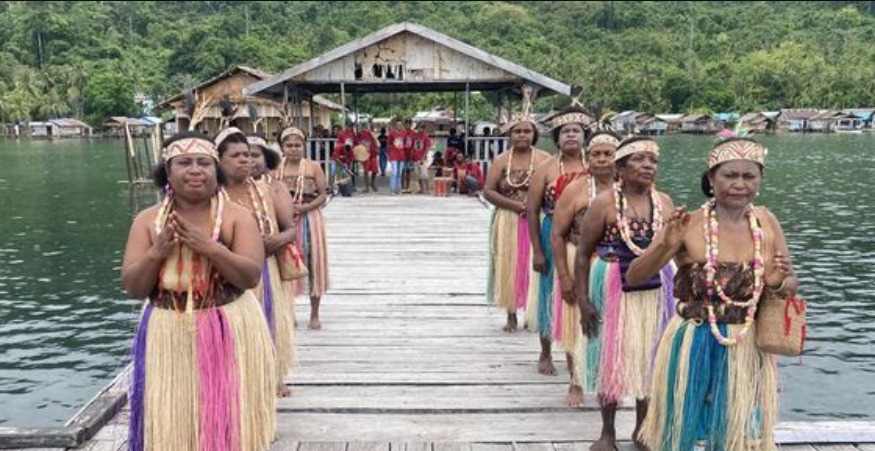PapuaAround.com – In the lush, verdant landscapes of Papua, where the natural world thrives alongside rich cultural traditions, the Sasi ceremony stands out as a poignant expression of environmental stewardship and community cohesion. This traditional practice, deeply rooted in the beliefs of the indigenous peoples of Papua, underscores the importance of sustainable resource management while reinforcing the ties that bind the community together.
Sasi is a customary practice primarily observed by various tribes in Papua, including the Maluku and other coastal communities. The term “Sasi” translates to “prohibition” or “forbidding,” reflecting the ceremony’s core principle: to protect and preserve natural resources during designated periods. This practice is a testament to the indigenous peoples’ profound understanding of the need to balance human needs with environmental sustainability.
Traditionally, Sasi is enacted for a variety of natural resources, including fish, shellfish, and agricultural produce. When a Sasi period is declared, specific areas are off-limits for harvesting, allowing ecosystems to recover and replenish. The community comes together to observe this prohibition, fostering a sense of responsibility towards nature and ensuring that resources remain available for future generations.
The Sasi ceremony typically begins with a communal gathering, where leaders and elders discuss the necessity of implementing Sasi for a particular resource. This discussion often includes an analysis of environmental conditions, such as declining fish populations or the health of agricultural lands. Once the decision is made, a designated area is marked, signaling the start of the Sasi period.
During the ceremony, rituals and prayers are performed to seek blessings from ancestral spirits and express gratitude for the resources the community relies upon. Offerings may include traditional foods, fruits, and flowers, symbolizing respect for the land and its bounty. Elders, revered as custodians of knowledge, often share stories and teachings related to the importance of conservation and the history of Sasi practices.
Read also: The Perang Dance, A Vibrant Expression of Papua’s Cultural Heritage
As the Sasi period unfolds, the community actively engages in alternative activities, such as fishing in permitted areas, gathering other food sources, or participating in cultural events. This not only reinforces community ties but also ensures that traditional knowledge and skills are passed down to younger generations.
The benefits of the Sasi ceremony extend beyond cultural preservation; they significantly impact environmental conservation as well. By allowing ecosystems to recover during Sasi periods, communities can restore biodiversity and maintain the balance of marine and terrestrial resources. This practice is crucial in a world facing the challenges of overfishing, deforestation, and climate change.
Research has shown that communities practicing Sasi often experience more sustainable yields when harvesting resumes. Fish populations, for example, rebound during Sasi periods, leading to increased catches once restrictions are lifted. This cyclical approach not only secures food sources but also reinforces the community’s relationship with the environment.
Moreover, the Sasi ceremony serves as an educational platform, teaching younger generations about the importance of conservation and the intricate balance between humans and nature. Through participation in the rituals and discussions, children and young adults learn valuable lessons about responsibility, sustainability, and the need to respect the natural world.
Despite its cultural and environmental significance, the Sasi ceremony faces challenges in the modern era. The encroachment of commercial fishing, urbanization, and climate change threaten the very resources that Sasi aims to protect. Many younger community members are drawn to urban life, resulting in a disconnect from traditional practices and knowledge.
To combat these challenges, community leaders and cultural advocates are working to revitalize the Sasi ceremony. By integrating modern conservation principles with traditional practices, they aim to raise awareness about the importance of sustainable resource management. Workshops, festivals, and educational initiatives are being implemented to inspire younger generations to engage with their cultural heritage and recognize the value of Sasi.
This ceremony is a powerful reminder of the deep connection between culture and nature in Papua. It exemplifies how traditional practices can offer solutions to contemporary environmental challenges while fostering community cohesion and cultural identity. As Papua continues to navigate the complexities of modernity, the resilience of the Sasi tradition offers hope for the preservation of both its rich cultural heritage and the natural world. By honoring these practices, the people of Papua not only safeguard their traditions but also contribute to a more sustainable future for generations to come.

